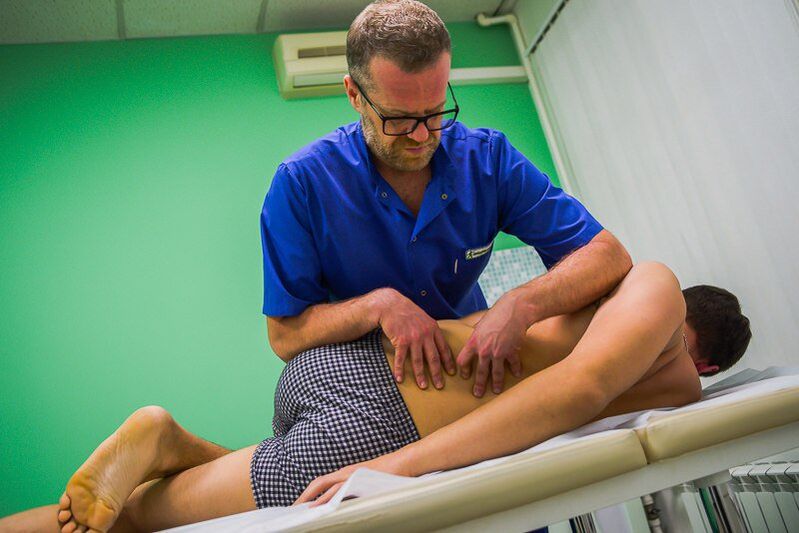
A modern person, having crossed the age limit at the age of 25, frequently begins to experience pain in the lower back, of varying frequency and intensity. Over time, the incidence of unpleasant symptoms increases, and the sensations of pain also increase. The exacerbation period is getting longer and longer. This is the clinical picture of the development of lumbar osteonecrosis - a disease in which there is a gradual destruction of the cartilage tissue of the disc. They become thinner, deformed, convex. In severe cases, without proper treatment, the low back pain becomes unbearable and interferes with normal movements. At this stage, as a rule, a lumbar herniated disc is diagnosed.
This is a kind of retribution for one's upright posture and upright body position. During the transition to an upright position, the center of gravity shifts, which we have in the lumbar region. This means that the full weight of the body when walking, running, jumping, bending and other movements puts pressure on the lumbar vertebrae. With an incompletely developed musculature of the back and abdominal presses, destruction of the intervertebral discs, the appearance of osteoblasts and other pathological formations occurs. And these are common causes of back pain.
Other causes of back pain
In addition to osteonecrosis and its complications, there are other causes of lower back pain. First of all, it is necessary to rule out various injuries, whereby both the integrity of the cartilage layer and the vertebral body may be affected. These can be vertebral fractures, spine fractures, compression fractures of the spine with displacement of spinal structures.
Lumbar injuries can result from frontal and tangential collisions, falls from heights, and traffic accidents. Usually when injured, professional athletes who participate in weightlifting sports will ask for an appointment.
In women, low back pain can be caused by pelvic inflammatory disease. Chief among them is appendicitis. In second place is polycystic ovary syndrome, which causes episodes of low back pain and soreness that are worse at certain times of the menstrual cycle. After 45 years, it is not uncommon for low back pain in women to be caused by tumor processes - uterine fibroids, ovarian and cervical cancer.
In both sexes, there are causes of low back pain such as inguinal hernia and kidney disease: pyelonephritis, polycystic kidney disease, amyloidosis, glomerulonephritis. To rule out kidney disease, it is necessary to consult a nephrologist and do a urinalysis according to Nechiporenko, according to Zimnitsky. Helps in differential diagnosis by renal ultrasonography.
In some cases, the cause of pain in the upper back is intercostal neuralgia or shingles. The first condition can be differentiated by palpation of the intercostal spaces. Usually, with intercostal neuralgia, this causes intense pain and is characterized by unilateral localization. With shingles, a rash can be seen on the skin as small blisters filled with clear liquid.
More dangerous causes of back pain can be tuberculosis and sarcoma. These diseases leave little chance of recovery. They are sometimes disguised in their early stages as ankylosing spondylitis, which also presents with stiffness on movement and severe pain in the lower back in the morning. Then all the symptoms disappeared.
Back pain: what to do?
If the lower back hurts - what to do in this case, to which doctor to seek help? You can make an appointment with a therapist who, after a careful examination, will make an initial diagnosis and order further examination. Mandatory are: general urinalysis, general blood tests, ultrasound of the kidneys and urinary tract, exclusion of tumor processes in the abdominal cavity. After that, a consultation with a neurologist, a gynecologist (for women) and a pediatrician may be indicated. To clarify the localization of the destruction process in the spine, radiological and tomographic examination methods can be used.
Prescribing treatment depends on the diagnosis. With osteosarcoma of the lumbar spine, it can only be completely treated with manual therapy methods. In the early stages, the pain is relieved with the help of traction, chiropractic and therapeutic massage. Then the doctors worked to restore the cartilage structure. In order to enhance the regenerative process, acupressure, acupuncture, and minimal drug delivery to biologically active points on the human body can be used.
After restoration of physiological mobility, complex rehabilitation therapy should be continued. It includes physical therapy and massage. You should also follow the recommendations of experts on organizing your diet, work and rest, and organize your workplace and sleep. In some cases, a brace may be required temporarily to support the spine.

























